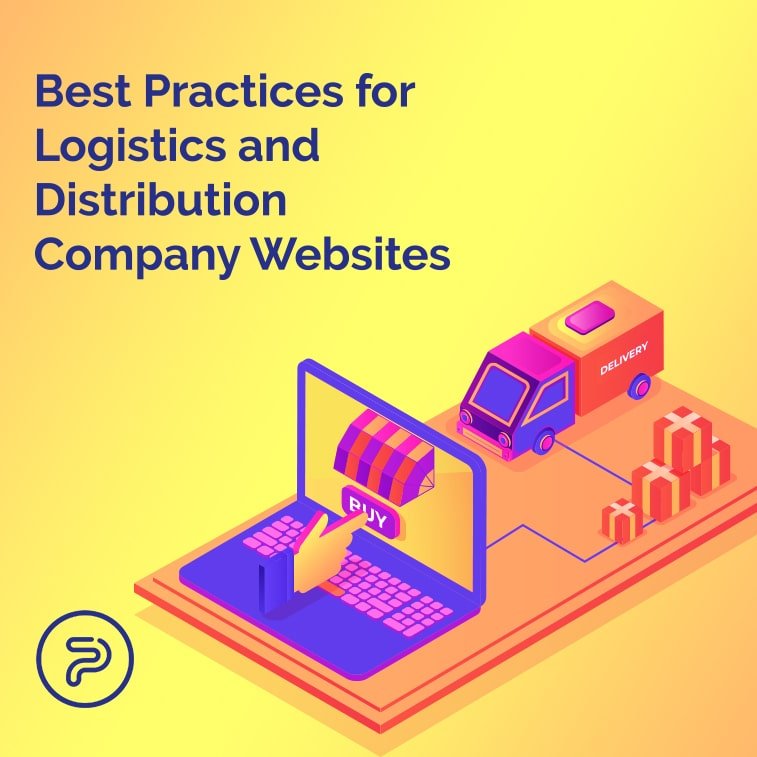Competition among distribution and logistics firms is just as fierce as among other companies in other, more “in-your-face” industries (for lack of better words), and every logistics professional can attest to that.
When you think about it, the transportation of goods has become pretty much the norm for all of us, and we take it for granted to an extent that the only time we take notice is when deliveries fail to arrive.
With distribution companies being so prevalent in our everyday life, these firms try their best to establish a persuasive and strong online presence in order to rise above the competition.
With a carefully crafted website, these companies can gain the desired advantage in the marketplace by using relevant information about themselves, their services. To put it more simply, they use their site as a tool for marketing – for better customer retention.
However, a website in itself is no guarantee for a stronger online presence. In order to get the most out of a web application, there are a few necessary steps and tactics that should be taken into account during the development cycle.
The company type dictates the trend
There are certain differences between the most common types of distribution companies and their websites should aim to reflect those differences.
Freight Marketplaces – These websites are usually used by companies that act as intermediaries between carriers and shippers. Usually, they have no fleet of their own, generating their revenue from matching demand and capacity – bringing together carriers and shippers.
Corporate Websites – These web apps are run by companies using them to give out info to their clients about their company mission, fleet, services, trends, news, and so on.
Freight Forwarders – These types of sites offer a wide range of different services for visitors from warehousing, transporting, distribution, packaging, and more. They are more like agencies that arrange the complete movement of goods from location A to location B.
As you can see, based on the different company models, websites should encourage different features and functionality.
Starting a project
Before getting started with the development cycle, web developers and business owners should take their time to sit down and talk about the website and the business model of the company.
Programmers should fully understand how the business model works so they can map out the site and all the features accordingly. A single-page application may be enough for a startup company but might not suit the needs of a well-established freight forwarder firm.
As such, let’s see some of the most important features every type of website should have:
Corporate Website Essentials
- User confidence – The development team should focus on creating a website that puts the business in the best possible light, ensuring that it makes a good impression for visitors. The main goal of a good corporate site is to come across as reliable and professional- with functionality and aesthetics blended in perfect harmony.
- Gaining trust – Another great way to represent the company in its best light is by adding detailed information about the services the company offers, along with certificates and awards. Pointing out the advantages that the potential clients will gain when choosing them is highly advised. Including testimonials is also a must since it helps “humanizing” the content on the website.
- Make the company shine – The copy on the website should reflect that the company is ready to take on difficult tasks and has already had experience with demanding jobs in the past. Also, the website should be able to tell the story of the company, so showcasing real faces from the firm along with pictures of the fleet and everyday situations can be a great way to get the visitors closer to the corporation.
- Be concise with the content– Don’t share too much too fast. If there are a lot of unnecessary details, visitors can get bored quickly and look for other options.
- Metrics– Service-related company statistics can become the driving force behind a successful logistics website. Using the latest web technology to include infographics and other stat figures, along with completed projects and client lists can convince visitors that this is the company they wish to do business with.
- Functionality – Content can surely go a long way, but including a few handy features can help the corporation stand out from the crowd and can help to improve user experience. With that said, standard features, like online shipment tracking and shipment cost & time calculators should be implemented.
- Visible “Contact us” sections– Use contact forms throughout the web application or link to the “Contact Us” page often, placing these sections at places where they can be clearly seen. Also, implementing a chat software or even chatbots can help boost the company’s conversion rates. Honestly, this might be a long reach for smaller companies so it’s vital to consult with your development team regarding your budget and needs.
- Mobile in mind – For seasoned developers, this shouldn’t come as a surprise. Nowadays, every website should look and feel streamlined and elegant on all devices and browsers. With logistics websites, this can be a crucial feature since a lot of customers like to check their shipment’s current status on the go, and they mostly do that from their mobile devices. Developing a dedicated mobile app can be a lengthy and costly process and might not be worth it for smaller companies.
Freight Marketplace Essential Features
- General features – Just as with corporate websites, developers should aim to create trust between the service provider and the potential client. As such, by giving a detailed profile of services, including statistics, infographics, along with photos, client lists can go a long way. Also, adding a review system can enable clients to rate services and give prospects a better idea of the general quality of the same. Make it possible for the website owners to leave feedback as well.
- Relevant data – Freight marketplaces can benefit greatly on the digital surface thanks to the nature of their services. By starting a blog, site owners not only can publish company and industry news. They can also share legal information, advice regarding said info, market trends, research trends, and findings. The more relevant data the site owner shares, the higher their credibility that can translate into a better reputation and better conversion rates. This is more of a bonus feature, not necessarily a must. Clients can research legal information on government websites, find news from other sources, however, with everything being in one place, blogs can help driving better website traffic.
- Functionality – A simple to understand UI design and content scheme can give a positive experience. Generally speaking, you need a design that’s simple to navigate and can help clients make fast decisions, with streamlined processes focusing service resort.
- Payment, tracking, and communication – Cargo tracking is an essential feature here, along with adding different payment options. Getting quotes can help a lot too, so implementing chat or messaging features can make closing new deals more efficient. Unfortunately, this feature requires a lot of different cargo dimensions from the client’s side (like cargo weight, height, depth, etc.), so creating this feature can be complicated, however, in particular cases, for particular companies, it might work.
Freight Forwarder Website Essentials
- Best of both worlds– Detailed service information, case studies, project details can all have their place on the website. Content-wise, while site owners have more options than corporate or freight marketplace representatives but may want to tone it down a bit and unless blog posts are in question. Blogs can include everything from tips, tricks, legal advice, to news and trends from a wide range of respective topics. However, it’s not imperative to include all these features. Depending on the profile, size, and work strategy of the company, statistics can be handed out on-demand, along with on-demand logistics info. The main goal here is to highlight the best of what the company has to offer.
- Leave out complexity – The website should be easy to navigate and to understand with services and contact options highlighted in distinctive places.
- Cargo shipping, payment, estimated costs – Especially with freight forwarder websites, these should be essential features, however, in practice, a lot of time, forwarders do not receive all the necessary info (cargo/shipment dimensions) needed to make the feature useful. Integrating such functionality is a great plus, however, more or less, only those companies will benefit from it where it is guaranteed that all the dimensions will be given.
- Mobile apps, business intelligence systems – Freight Forwarders can highly benefit from a designated mobile app, but still, need a highly responsive website since some customers will still use a mobile browser to reach it.
General design features
Now that most business model-specific features have been outlined, it’s time to focus on more generalized guidelines that should be applied in order to create a great website.
Navigation consistency and simplicity
We’ve already stated that ease of use should be a primary concern. The website’s navigation should be easy to grasp and consistent, with the menu staying the same on every page, with the company logo on the left top corner.
As such, the search box should be clearly visible too, to help visitors find what they are looking for more efficiently.
Scrolling the website should be easy, with a visible scroll bar, and pages shouldn’t be too long.
Keeping things simple is essential because a lot of people aren’t really that tech-savvy, making it hard for them to navigate through more complex design solutions. Visitors abandoning websites because they find it hard to navigate is a huge negative, so developers should aim to keep things simple.
A fast website equals a happy customer
This should go without saying, but these websites should be fast-loading. Every web developer knows that every second counts and sites that take longer to load lose valuable customers each day. As such, every page should load quickly.
Distinctive CTAs, links, and social share buttons
Interactive CTA buttons with animations can be a great tool for drawing attention, but use them with taste. Links should also be clearly visible so there’s a better chance for visitors of opening them.
Lastly, social media now plays an integrated role in our lives so adding social media follow and share options should also be implemented. It can help with raising brand awareness along with improving conversion rates. Adding login options with social credentials can also pay off.
Stay coherent visually
A consistent visual identity can reinforce trust in visitors, so design-wise, the development team should aim for perfect visual harmony. Create icons and color schemes accordingly, along with quality background imagery. Make the schemes and the design coherent not just with the website, but with the nature of the services too.
Conclusion
All in all, logistic and distribution company websites should serve as immersive business cards for their respective owners and as such, UX and UI features should be streamlined with developers and designers working closely together not just with each other but with company representatives too in order to create a website that has the right balance of functionality, marketing power, and visual harmony.





